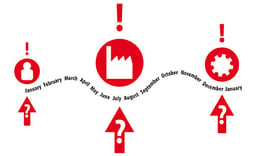How Container Pull Solutions Are Like X-Ray Vision
Nick Ostdick - September 27, 2016

 Imagine you had the ability to see through walls. You’d be able to know instantly if your coat is hanging in the closet, if your dog is behaving poorly in the adjacent room, or if you in fact left your car keys in the ignition after coming home from the grocery store. X-ray vision would allow you to have greater insight into things previously unseen, which would not only make your life easier but also more efficient.
Imagine you had the ability to see through walls. You’d be able to know instantly if your coat is hanging in the closet, if your dog is behaving poorly in the adjacent room, or if you in fact left your car keys in the ignition after coming home from the grocery store. X-ray vision would allow you to have greater insight into things previously unseen, which would not only make your life easier but also more efficient.
Now, imagine if supply chain planners and managers had the same capability when it comes to container load management and being able to access the right parts in the right container at the right time to ensure planned productions continue as scheduled. Wouldn’t X-ray vision be quite the value proposition for planners in achieving greater visibility about the quantity and condition of parts within any given container, especially given the variant-rich nature and constantly shifting variables and constraints in the automotive supply chain?
An integrated container pull solution, though not quite on the level of X-ray vision, allows for this level of insight and visibility into containers within the yard to help planners assess the current supply situation and respond to the changing demands and constraints often associated with planned productions - the parameters of which often shift while containers are in transit. Through powerful optimization tools, container pull solutions help planners determine which containers in the yard provide part coverage for current demand and which should be unloaded to combat shortages, overages, or inventory issues.
In short, container pull solutions, much like X-ray vision, allows planners and manager to see what was previously unseen to create consistency and agility across each touch point of a company’s value chain.
Importance of Container Pull Solutions
Still not convinced about the value of an optimized container pull solution? Analogies to X-ray vision aside, the importance of container pull solutions cannot be understated when conceiving a supply stream based on lean supply chain management principles and an eye for efficiency and growth in the short and mid-term. Planned production programs, resource allocation, facility and machinery management, and other variables are always subject to modification - sometimes while parts within containers are moving from location to location - and container pull solutions help mitigate the risks of these variables in causing disruptions and bottlenecks.
First, as we referenced earlier, a container pull solution provides planners with a holistic view of the entire supply situation by assessing the quantity and status of parts in any number of given containers. This allows planners and managers to evaluate and optimize the selection and movement of containers based on defined conditions and planned production schemes. In addition, bottlenecks and disruptions can be predicted long before they occur, which results in a cost-optimal securing of parts supply, based on rules and objectives needed to support production.
Secondly, an integrated container pull solution provides planners with a clear, user-friendly interface that allows them to comprehensively view warehouse inventory, as well as in the upstream container yard or other points of the supply chain. Planners can also perform detailed analysis on how many days, shifts, or hours of production can be satisfied from the part inventory at the production area, in the warehouse, or the container yard as well as which containers should be prioritized to prevent additional costs such as demurrage.
Similar functionalities exist for view of the container yard whereby planners can analyze each of those containers in detail as well as manage the status or their availability. Not only is the planner able to see what parts are included in the container, but they can also examine the attributes of those parts including which scheduling conditions apply to that specific container.
Benefits of Container Pull Solutions
Now that we understand the importance of a container pull solution in leveraging a lean, efficient supply chain, we can further appreciate and understand the benefits this solution provides companies in managing global supply and production networks. While the holistic benefits of a container pull solution reach across multiple touch points of a company’s value chain, there are a handful of potential value propositions companies stand to experience within the supply stream alone.
Minimized Warehouse Inventory. By incorporating optimization into the container pull management process, inventory can be minimized by providing visibility of parts required for demand coverage and selecting the container that best satisfies the part requirements. This allows planners and managers to focus on the parts necessary for production while minimizing the handling of low priority parts. This level of optimization reduces the likelihood of overages or shortages at the production facility and warehouse level, which is a critical driver in ensuring smooth, streamline supply streams.
Enhanced Efficiency. By optimizing the unloading of the containers, planners and managers can take proactive measures to manage aging containers, those that are about to incur demurrage charges or violate custom regulations or other variables. This improves the efficiency of dock management, pre-planning for additional storage space, or possibly identifying the need for outsourcing. Enhanced efficiency is also achieved by reducing the number of instances parts or part families must be unloaded from containers in order to provide enough materials for the demands of various production programs.
Reduced Special Handlings. With complete visibility of part inventories at each storage level in the overall supply chain, planners and managers can utilize actionable data to avoid conditions resulting in costly expedites, special handling of parts, or the unnecessary transfers across storage locations. Reduction in the unnecessary movement of parts, part families, or unloading of containers not only foster a more cost-effective supply stream, but also help reduce the resources, materials, and personnel necessary for efficient yard, dock, and container management.
LATEST POSTS
- Understand Circular Economy in The Manufacturing Industry
- How Can Industry 4.0 IT Integration Be Achieved Smoothly?
- The Significance of Order Sequencing in Discrete Manufacturing
- How to improve your Supply Chain Management: The Power of Control Towers
- Optimizing Human Resource Scheduling in Manufacturing: A Technological Approach



